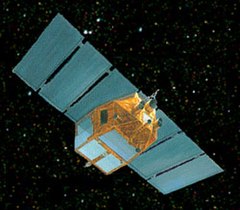 Artist's conception of BeppoSax in space (credit: the Italian Space Agency (ASI) and BeppoSAX Science Data Center (SDC)) | |||||||||||
| Names | Satellite per Astronomia X | ||||||||||
|---|---|---|---|---|---|---|---|---|---|---|---|
| Mission type | X-ray astronomy | ||||||||||
| Operator | ASI / NIVR | ||||||||||
| COSPAR ID | 1996-027A | ||||||||||
| SATCAT no. | 23857 | ||||||||||
| Website | www.asdc.asi.it/bepposax/ | ||||||||||
| Mission duration | 7 years | ||||||||||
| Spacecraft properties | |||||||||||
| Manufacturer | Alenia CNR | ||||||||||
| Launch mass | 3,100 lb (1,400 kg) | ||||||||||
| Payload mass | 1,060 lb (480 kg)ù | ||||||||||
| Dimensions | 3.6 m × 2.7 m (11.8 ft × 8.9 ft) | ||||||||||
| Power | 800 W | ||||||||||
| Start of mission | |||||||||||
| Launch date | 04:31, April 30, 1996 (UTC) | ||||||||||
| Rocket | Atlas-Centaur AC-78 | ||||||||||
| Launch site | LC-36B, Cape Canaveral | ||||||||||
| End of mission | |||||||||||
| Disposal | decommissioned | ||||||||||
| Deactivated | 13:38, April 30, 2002 (UTC) | ||||||||||
| Decay date | 22:06, April 29, 2003 (UTC) | ||||||||||
| Orbital parameters | |||||||||||
| Reference system | Geocentric | ||||||||||
| Regime | Low Earth | ||||||||||
| Eccentricity | 0.00136 | ||||||||||
| Perigee altitude | 575 km (357 mi) | ||||||||||
| Apogee altitude | 594 km (369 mi) | ||||||||||
| Inclination | 4 degrees | ||||||||||
| Period | 96.4 minutes | ||||||||||
| Epoch | 30 April 1996, 03:31 UTC[1] | ||||||||||
| Main telescope | |||||||||||
| Type | approximated Wolter type I Coded mask telescope (WFC) | ||||||||||
| Diameter | 6.8 to 16.2 cm (2.7 to 6.4 in) | ||||||||||
| Focal length | 1.85 m (6.1 ft) | ||||||||||
| Collecting area | 22 to 600 cm2 (3.4 to 93.0 sq in) | ||||||||||
| Wavelengths | X-ray to gamma ray, 12 nm–4 pm (0.1–300 keV) | ||||||||||
| Instruments | |||||||||||
| |||||||||||
BeppoSAX was an Italian–Dutch satellite for X-ray astronomy which played a crucial role in resolving the origin of gamma-ray bursts (GRBs), the most energetic events known in the universe. It was the first X-ray mission capable of simultaneously observing targets over more than 3 decades of energy, from 0.1 to 300 kiloelectronvolts (keV) with relatively large area, good (for the time) energy resolution and imaging capabilities (with a spatial resolution of 1 arc minute between 0.1 and 10 keV). BeppoSAX was a major programme of the Italian Space Agency (ASI) with the participation of the Netherlands Agency for Aerospace Programmes (NIVR). The prime contractor for the space segment was Alenia while Nuova Telespazio led the development of the ground segment. Most of the scientific instruments were developed by the Italian National Research Council (CNR) while the Wide Field Cameras were developed by the Netherlands Institute for Space Research (SRON) and the LECS was developed by the astrophysics division of the European Space Agency's ESTEC facility.[2]
BeppoSAX was named in honour of the Italian physicist Giuseppe "Beppo" Occhialini. SAX stands for "Satellite per Astronomia a raggi X" or "Satellite for X-ray Astronomy".[2]
X-ray observations cannot be performed from ground-based telescopes, since Earth's atmosphere blocks most of the incoming radiation. One of BeppoSAX's main achievements was the identification of numerous gamma-ray bursts with extra-galactic objects.[3]
Launched by an Atlas-Centaur on 30 April 1996 into a low inclination (<4 degree) low-Earth orbit, the expected operating life of two years was extended to April 30, 2002, due to high scientific interest in the mission and the continued good technical status. After this date, the orbit started to decay rapidly and various subsystems were starting to fail making it no longer worthwhile to conduct scientific observations.[4][5]
On April 29, 2003, the satellite ended its life falling into the Pacific Ocean.[6]
- ^ "NASA, NSSDC Master Catalog: 1996-027A". NASA. 6 July 2015. Retrieved 6 July 2015.
- ^ a b "Mission overview". Italian National Institute of Astrophysics. Retrieved October 13, 2022.
- ^ Feroci, Marco. "Observation of Gamma-Ray Bursts by BeppoSAX" (PDF). Stanford University. Retrieved October 12, 2022.
- ^ Cleary, Mark. "Atlas and Titan Space Operations at Cape Canaveral 1993-2006" (PDF). USAF 45th Space Wing History Office. Air Force Space Museum. Archived from the original (PDF) on 2022-12-01. Retrieved 2022-10-14.
- ^ Cite error: The named reference
saxstatwas invoked but never defined (see the help page). - ^ "Latest news from the BeppoSAX project". Italian Space Agency. Retrieved October 12, 2022.